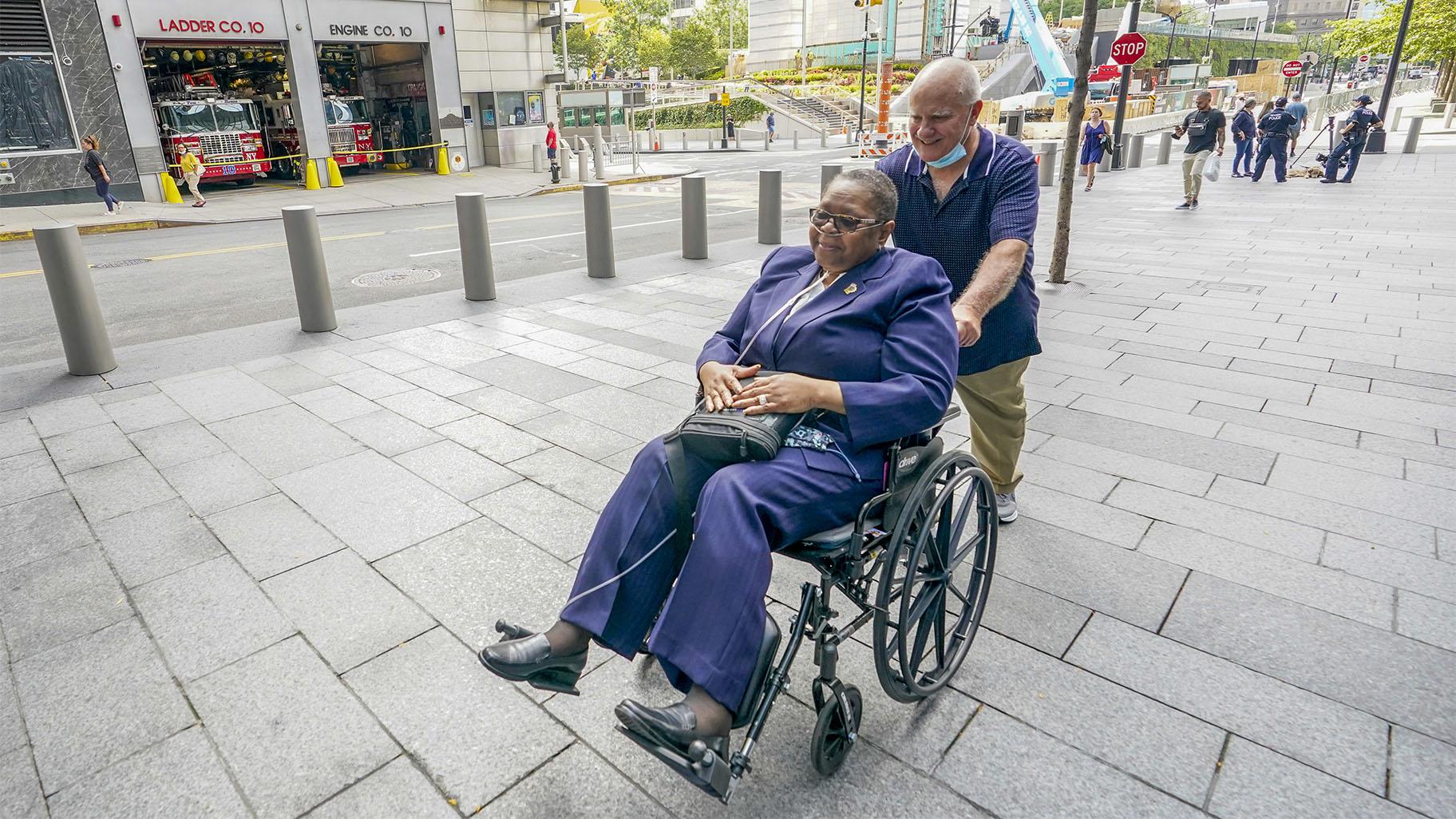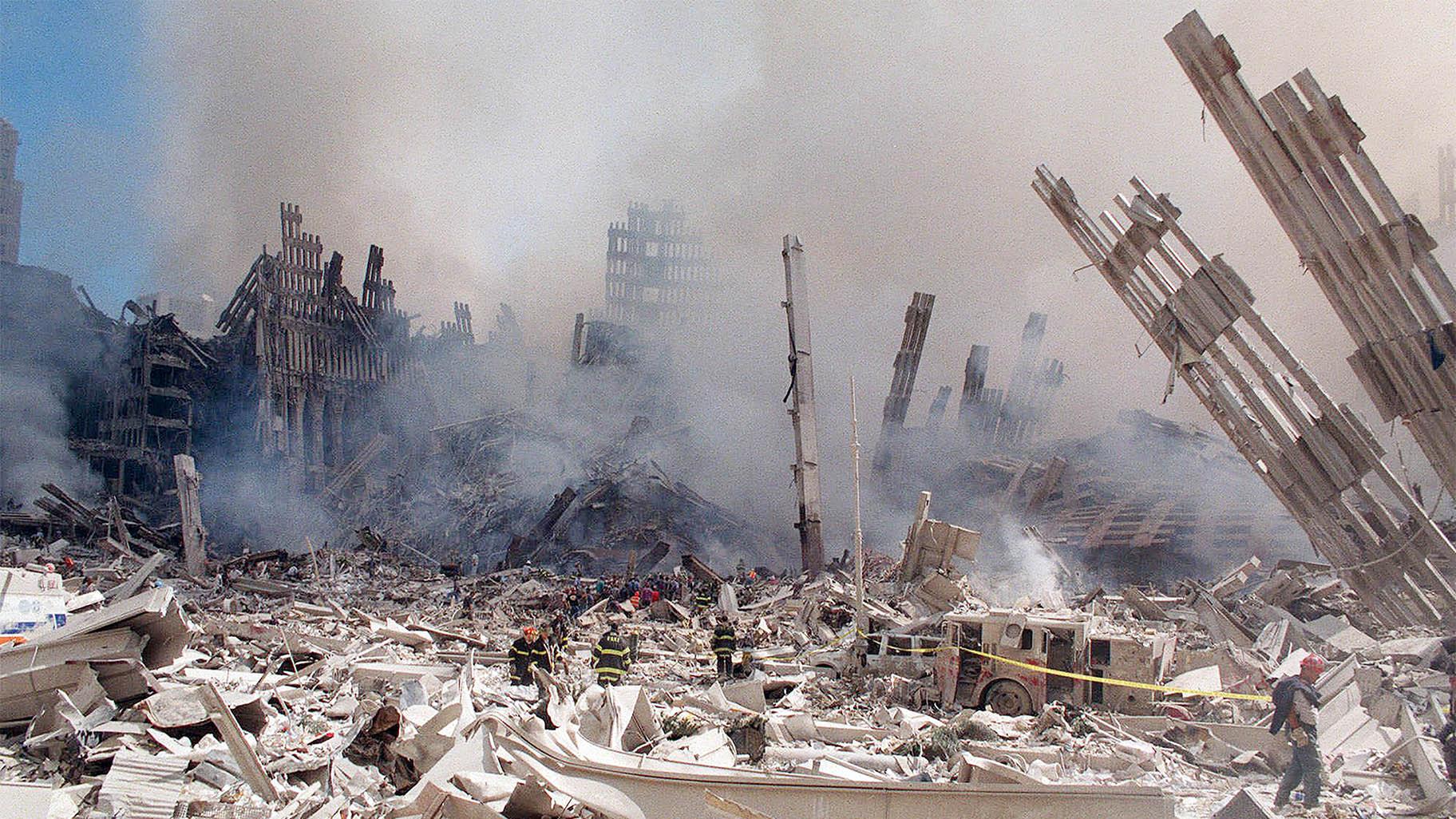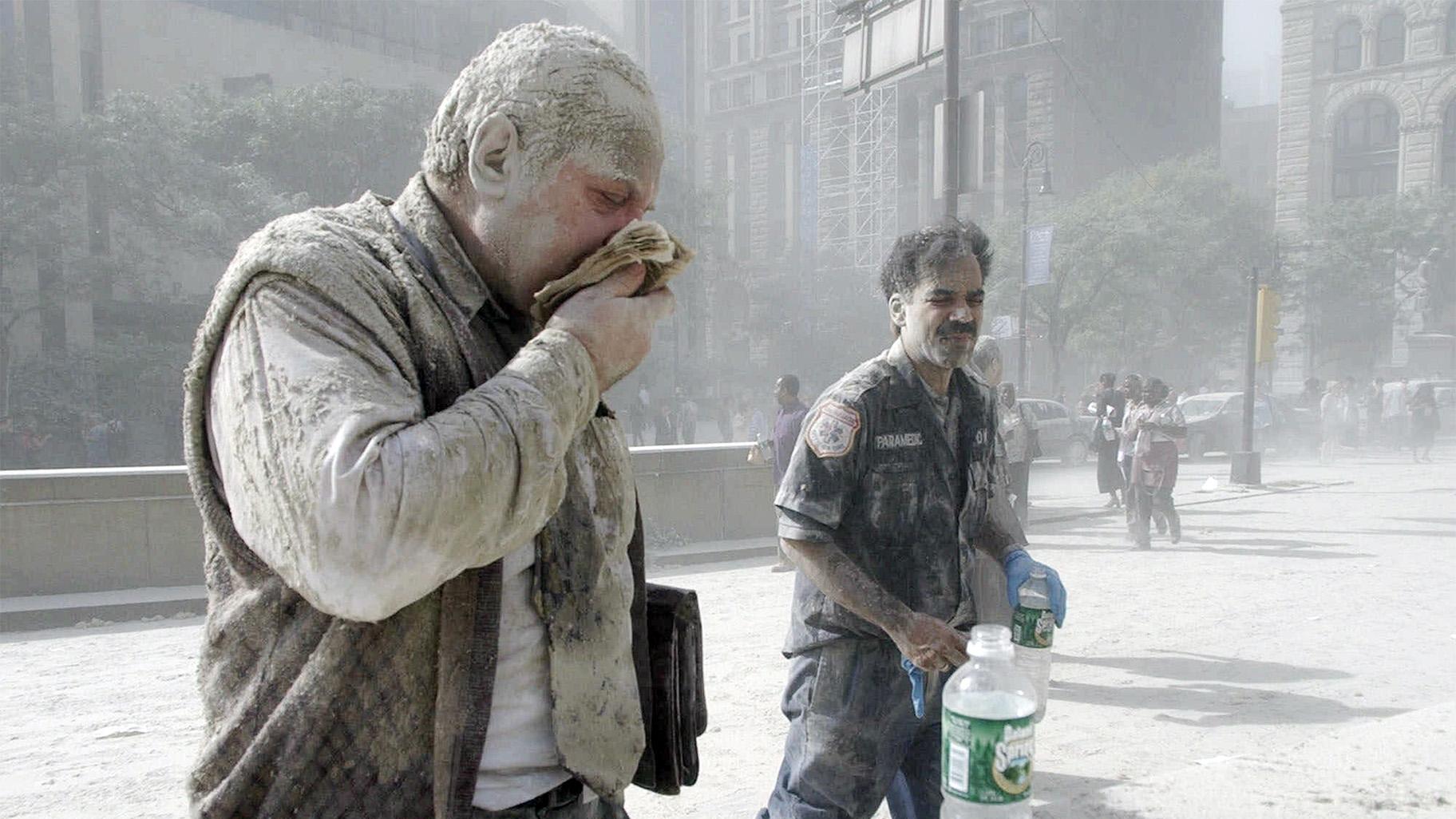In this September 11, 2001 file photo, dust-covered people from the collapsed World Trade Center building are walking through this part of New York. (AP photo / Suzanne Plunkett, file)
New York (AP) — A cloud of dust captured Karl Sadler near the East River, and his clothes and hair while looking for a way from Manhattan after he fled his office at the World Trade Center. I made it white.
Gray powder swirled through the open windows and terrace doors of the downtown Mariama James apartment, settling in her rug and the furniture in her children’s bedroom, sometimes in inches thick.
Police detective Barbara Burnette spewed soot from her mouth and throat for weeks while working on a pile of burning rubble without a protective mask.
Today, all three are among the more than 111,000 people enrolled in the World Trade Center Health Program. This program provides free medical care to people with health problems that may be related to dust.
Twenty years after the collapse of the Twin Towers, people are still willing to report any illnesses that may be associated with the attack.
To date, the United States has spent $ 11.7 billion in caring for and compensating for those exposed to dust. This is about $ 4.6 billion more than the amount given to the families of those killed or injured on September 11, 2001. A government fund for people with illnesses that may be associated with an attack.
Scientists are still uncertain how many people have developed health problems as a result of being exposed to large amounts of crushed concrete, glass, asbestos and gypsum.
Many people enrolled in a health program have symptoms that are common to the general public, such as skin cancer, gastroesophageal reflux disease, and sleep apnea. In most cases, there is no test that can determine if someone’s illness is related to trade center dust or the consequences of other factors such as smoking, genetics, and obesity.
Over the years, it has led to some friction between patients who are absolutely convinced they have a 9/11-related illness and doctors who are suspected.
 New York City Police detective Barbara Burnette (left) and her husband Lebro Burnette, who worked in the mountains of the World Trade Center for 23 days after the terrorist attack, left the 9/11 Memorial & Museum in New York on Wednesday, September 8, 2021. increase. yoke. (AP Photo / Mary Altafer)
New York City Police detective Barbara Burnette (left) and her husband Lebro Burnette, who worked in the mountains of the World Trade Center for 23 days after the terrorist attack, left the 9/11 Memorial & Museum in New York on Wednesday, September 8, 2021. increase. yoke. (AP Photo / Mary Altafer)
“At that time, most people thought I was crazy,” says Mariama James.
She initially convinces her doctor that a chronic ear infection, sinus problems, asthma that afflicts a child, or her own shortness of breath is associated with a large amount of dust that must be cleaned from the apartment. I had a hard time.
Years of research have provided partial answers to 9/11 health issues like her. The maximum number of people enrolled in the Federal Health Program suffers from chronic inflammation or reflux of the sinuses or nasal passages, a condition that can cause symptoms such as heartburn, sore throat, and chronic cough. ..
The reason for this is not well understood. Doctors say it may be related to the fact that your body is stuck in a cycle of chronic inflammation that was initially caused by the stimulus from dust.
Post-traumatic stress disorder has emerged as one of the most common and persistent health conditions, afflicting approximately 12,500 people enrolled in health programs. Nearly 19,000 registrants have mental health problems that may be related to the attack. Over 4,000 patients have some form of chronic obstructive pulmonary disease. This is a family of potentially debilitating respiratory disorders.
Time helped to heal some physical illnesses, but not others. Many first responders who develop chronic cough later disappear or disappear completely, but others show little improvement.
According to a fire department survey, about 9% of firefighters exposed to dust report that they still have a cough. About 22% report shortness of breath. About 40% still have chronic sinus problems or acid reflux disease.
Tests by fire department personnel who spent time at Ground Zero found that their lung function was 10 to 12 times greater than normally expected due to aging in the first year after 9/11. rice field.
On the encouraging side, doctors say their worst fears of the possible wave of deadly 9/11 cancer haven’t come true.
At least not yet.
 In this September 12, 2001 file photo, a firefighter is working in the rubble of the World Trade Center Tower in New York. (AP photo / Virgil case, file)
In this September 12, 2001 file photo, a firefighter is working in the rubble of the World Trade Center Tower in New York. (AP photo / Virgil case, file)
Approximately 24,000 people exposed to the dust of trade centers have had cancer in the last two decades. But in most cases, it was at a speed that was in line with what researchers expected of the general public. The most common is skin cancer, which is commonly caused by sunlight.
Although the incidence of some specific types of cancer, such as malignant melanoma, thyroid cancer, and prostate cancer, has been found to be slightly higher, researchers have found more cases in medical monitoring programs. It states that it may be due to the discovery of.
“There really isn’t a surge in cancer that I was afraid of,” says Dr. Michael Crane, director of the World Trade Center Health Clinic on Mount Sinai. “We were afraid that we might have epidemic lung cancer.”
One study showed that cancer mortality rates for firefighters and emergency medical personnel in dust-exposed cities of trade centers were actually lower than most Americans.
Beneficiaries of the screening include people like Burnett who first began treatment for lung disease (hypersensitivity pneumonitis with fibrosis) at Mount Sinai Clinic.
On one of these visits in 2017, the scan ended up detecting lung cancer.
“I don’t know if I didn’t attend the program, or if I didn’t meet Dr. Crane, they would have found it,” says Burnett. Since then, she has received two doses of chemotherapy. It didn’t cure her, but it kept the cancer away.
In the early days of the federal health program, many registered people were police officers, firefighters, and others who worked in the debris pile. But these days, most of the applications have come from people who worked or lived in Lower Manhattan. People like Karl Sadler were in the 76th floor office of Morgan Stanley in the South Tower of the Trade Center when they were struck and shaken by a hijacked aircraft. ..
“Millions of sheets of paper were popping out. Credenza. Computer,” says Salder. “I saw a chair flying, and it looked like there was a person there.”
He walked down the stairwell and escalator towards the street and left with the crowd. “When we arrived at Water Street, just one block away from the Fulton Fish Market, there was a big explosion that turned the clouds and everything into black ash and gray and covered them with soot,” he says.
Initially, Sadler’s health looked good. However, years after the attack, he began to get involved while exercising and suffering from recurrent bronchitis. In his 60s, he had to give up some outdoor activities like skiing and soccer.
“I just had a breathing problem, but I didn’t know what it was,” he says.
At the age of 80, he has been diagnosed with acid reflux disease, asthma, thyroid cancer and cutaneous melanoma for many years and has been successfully treated. He thought it was all part of aging until around 2017, when a friend proposed to enroll in the World Trade Center Health Program.
“He said,’You have a lot of health problems. You have a lot of health problems. You need to register,” Sadler says.
Last year, an additional 6,800 people participated in the health program. Not all members are currently ill. Many people are enrolled in case they get cancer in the future. Some people have improved their condition. According to program statistics, about 1,000 people in the program received inpatient treatment and about 30,400 received outpatient treatment last year.
The Victims Compensation Fund, which pays people with illnesses associated with attacks, has an unlimited budget from Congress, but medical programs can become very large and run out of money. The House of Representatives has submitted a bill that will provide an additional $ 2.6 billion over a decade to cover the expected funding gap after 2025.
Under this program, anyone who has worked or lived in a small slice of Lower Manhattan or Brooklyn is eligible for free care if they develop a particular illness. This list includes about 12 types of airway or gastrointestinal disorders, 10 types of mental illness, and at least 20 types of cancer.
Research is also underway that may add to the list of conditions of interest. The program’s administrator, Dr. John Howard, states that the conditions currently being studied include autoimmune disorders such as rheumatoid arthritis.
One of the early estimates was that 490,000 people could be covered. This is partly because there is no need to prove that the illness is associated with the September 11th attack. If there is a condition on the list, the person is presumed to be eligible.
“We cover lung cancer, regardless of attribution issues,” says Howard. “If you have lung cancer, we do not analyze how many packs of smoking you have been engaged in.”
 In this September 11, 2001 file photo, a man covered in dust and debris from a cough collapse at the South Tower of the World Trade Center near New York City Hall. (AP photo / Amy Sansetta, file)
In this September 11, 2001 file photo, a man covered in dust and debris from a cough collapse at the South Tower of the World Trade Center near New York City Hall. (AP photo / Amy Sansetta, file)
From a public health perspective, what will happen to those who were there that morning and in the days and weeks that followed for the next 20 years after 9/11?
The average age of federal health program registrants is now around 60, and Dr. Jacqueline Moleen, director of the World Trade Center Health Clinic at Northwell Health Medical Systems, is concerned that people’s health problems worsen with age. I am. Cancer caused by asbestos can take up to 40 years after exposure, she said.
“We’re at a point where we might start seeing things,” says Moleen. She is also deeply concerned about the long-term effects of post-traumatic stress.
In addition to psychological harm, the constant impact of adrenaline and other stress hormones associated with PTSD can exacerbate heart problems and weaken the immune system. And along with that, the emotional and physiological ripples of one day in September 20 years ago can collide in new and debilitating ways.
Cranes, who have been treating Ground Zero Responders from the beginning, say one thing is clear, based on the ongoing flow of new patients. The problem has not been resolved.
“They keep coming,” he says. “They keep coming into the door.”
Twenty years later, fallout from the toxic WTC dust cloud grows | Chicago News
Source link Twenty years later, fallout from the toxic WTC dust cloud grows | Chicago News
The post Twenty years later, fallout from the toxic WTC dust cloud grows | Chicago News appeared first on Illinois News Today.


No comments:
Post a Comment